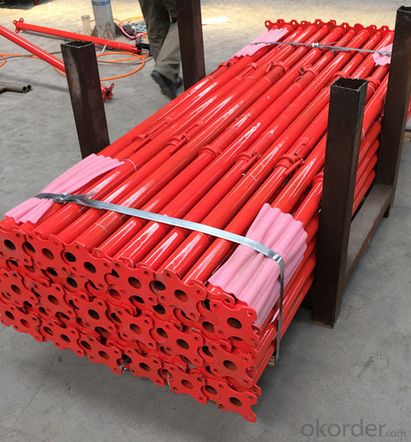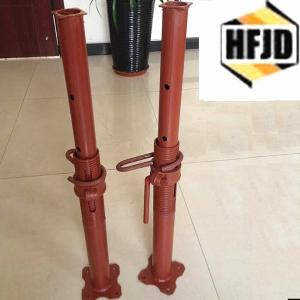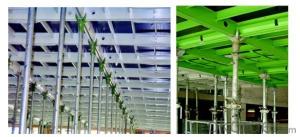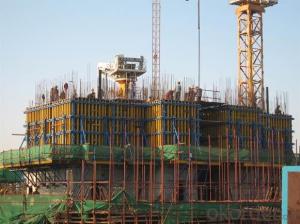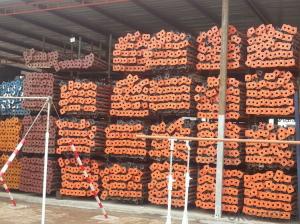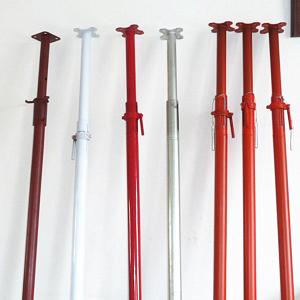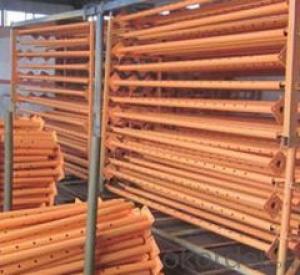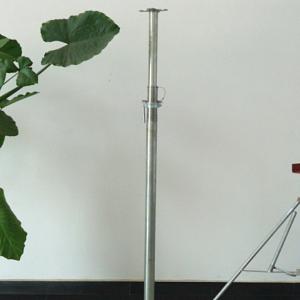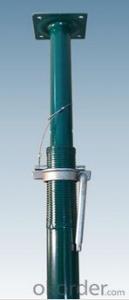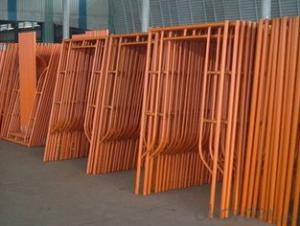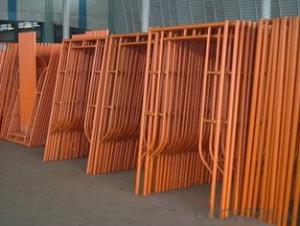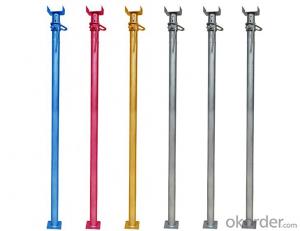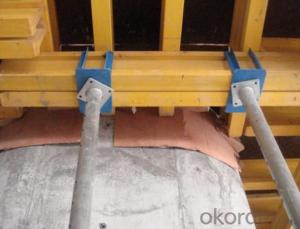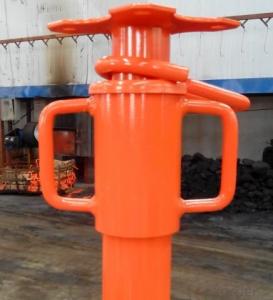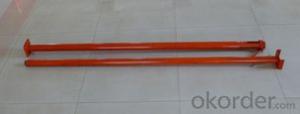Stable and durable steel scaffolding shoring prop
- Loading Port:
- Tianjin
- Payment Terms:
- TT OR LC
- Min Order Qty:
- 10000 PCS
- Supply Capability:
- 10000 PCS/month
OKorder Service Pledge
OKorder Financial Service
You Might Also Like
Quick Details
| Model Number: | SP scaffolding shoring prop | ||||
| Material: | Q235 steel pipe | Color: | dark red, green, blue | Surface treatment: | painted, powder coated, galvanized |
| Certification: | SGS;BV | Length: | 1600-4000mm | Thickness: | 1.8/2.0/2.2/2.5/3.0mm |
| Technique: | CO2 arc welded | Inner tube diameter: | 40/48mm | Outer tube diameter: | 48/56/60mm |
| Application: | scaffolding shoring prop for slab and formwork supporting |
Packaging & Delivery
| Packaging Detail: | 1.Scaffolding shoring prop is in a bundle with a wire which is in bare package. 2.One 20 GP container can load around 1500-2000 pieces of props. |
| Delivery Detail: | 10-20 days after deposit |
Specifications
scaffolding shoring prop
1.For slab supporting
2.CO2 arc welded technique
3.High loading capacity
4.Rust-proof
SpecificationsChina)
| Product | Model | Specifications |
scaffolding shoring prop | Inner tube diameter |
40/48mm |
| Outer tube diameter |
48/56/60mm | |
| Tube thickness |
1.8/2.0/2.2/2.5/3mm | |
| Adjustable length | 1600-2900mm 1800-3200mm 2000-3600mm 2200-4000mm |
*We can provide diffenet sizes and types of scaffolding shoring prop for you .
- Q: Can steel props be used for supporting temporary seating arrangements?
- Yes, steel props can be used for supporting temporary seating arrangements. Steel props are commonly used in construction for providing temporary support, and their adjustable height and strength make them suitable for supporting various structures, including temporary seating arrangements.
- Q: How do you prevent theft of steel props from construction sites?
- There are several measures that can be taken to prevent theft of steel props from construction sites. Firstly, implementing a secure fencing system around the site with access control mechanisms can significantly deter thieves. Additionally, installing security cameras and proper lighting can help identify any suspicious activities. Storing steel props in a locked and monitored storage area when not in use can also minimize the risk of theft. Conducting regular inventory checks and keeping records of the props can aid in identifying any missing items quickly. Lastly, involving local authorities and collaborating with neighboring businesses or residents to report any suspicious activities can further enhance security and deter theft.
- Q: Can steel props be used for temporary shoring?
- Yes, steel props can be used for temporary shoring. Steel props are adjustable supports that provide temporary support to structures during construction or renovation work. They are commonly used in the construction industry to support walls, beams, and floors, as well as to stabilize structures during excavation or demolition. Steel props are preferred for temporary shoring because they are strong, durable, and can be easily adjusted to different heights. They can also be used in a variety of conditions, including uneven ground or confined spaces. Additionally, steel props are designed to distribute the load evenly, ensuring the stability and safety of the temporary structure. Therefore, steel props are a reliable and effective solution for temporary shoring needs.
- Q: Are steel props suitable for supporting temporary recreational facilities?
- Yes, steel props are suitable for supporting temporary recreational facilities. Steel props provide strong and stable support, making them ideal for ensuring the safety and stability of temporary structures such as recreational facilities.
- Q: Can steel props be used in renovation projects?
- Yes, steel props can be used in renovation projects. Steel props, also known as adjustable steel props or acrow props, are commonly used in construction and renovation projects to support temporary loads. They provide temporary support to ceilings, walls, or beams during renovations, repairs, or alterations. Steel props are adjustable in height, allowing them to be used in a variety of applications. They are easy to install, dismantle, and transport, making them suitable for both small and large-scale renovation projects. Steel props are designed to be strong and stable, providing reliable support during the renovation process.
- Q: Are there any specific regulations or standards that govern the use of steel props?
- Steel props are subject to specific regulations and standards that govern their use. These measures aim to guarantee the safety and structural integrity of supported structures. Many countries enforce building codes and regulations that establish the minimum requirements for the design, installation, and usage of steel props. For instance, in the United States, the Occupational Safety and Health Administration (OSHA) provides regulations and guidelines within the Construction Industry Safety and Health Standards (29 CFR 1926) that pertain to the temporary use of steel props. These regulations specify criteria for their design, installation, inspection, and removal to prevent accidents and safeguard workers. Additionally, various organizations and standards bodies have formulated specific standards and guidelines for steel prop usage. A notable example is the British Standard BS 4074, which offers guidance on the design, construction, and utilization of adjustable steel props in temporary support structures. These regulations and standards commonly address load capacities, maximum heights, spacing requirements, bracing, stability, and safe work practices. They also frequently necessitate comprehensive documentation, including usage instructions, maintenance records, and regular inspections. It is crucial for construction professionals, contractors, and workers involved in the utilization of steel props to have a comprehensive understanding of these regulations and standards. Adherence to these guidelines ensures the safety of personnel and the structural stability of supported structures.
- Q: What are the different types of steel prop base plates available?
- There are several different types of steel prop base plates available, each designed for specific purposes and applications. 1. Flat Base Plate: This is the most common type of base plate used with steel props. It is a flat, square or rectangular plate that provides stability and support to the prop. Flat base plates are versatile and can be used in various construction projects. 2. U-Head Base Plate: This type of base plate has a U-shaped indentation in the center, which allows for easy placement and adjustment of the prop head. U-head base plates are commonly used in formwork applications, where the prop head needs to be securely held in place. 3. Fork Head Base Plate: Fork head base plates have a fork-like structure, with two prongs that allow for secure placement of the prop head. This type of base plate is often used in scaffolding systems, where the prop head needs to be held firmly in position. 4. Tilt Base Plate: Tilt base plates are designed to provide additional flexibility and adjustment options. They feature a tilting mechanism that allows for easy adjustment of the prop angle. Tilt base plates are commonly used in applications where the props need to be placed at an angle or on uneven surfaces. 5. Adjustable Base Plate: As the name suggests, adjustable base plates can be adjusted in height to accommodate different prop lengths. They often have a threaded shaft that can be extended or retracted to achieve the desired height. Adjustable base plates are suitable for projects where props of varying lengths are required. 6. Swivel Base Plate: Swivel base plates are equipped with a swiveling mechanism that allows for 360-degree rotation. This type of base plate is commonly used in applications where props need to be adjusted or relocated frequently. It is important to choose the right type of steel prop base plate based on the specific requirements of the project, as each type offers different features and advantages.
- Q: How do steel props contribute to the overall cost-effectiveness of a project?
- Steel props contribute to the overall cost-effectiveness of a project by providing a cost-effective solution for temporary support during construction. They are durable, reusable, and easy to install, reducing the need for excessive labor and material costs. Additionally, steel props have adjustable heights and load-bearing capacities, allowing for efficient customization and flexibility in various construction scenarios.
- Q: Can steel props be used for temporary support in power transmission tower construction?
- Yes, steel props can be used for temporary support in power transmission tower construction. Steel props are strong and durable, making them suitable for supporting heavy loads during the construction process. They can be easily adjusted and secured in place, providing stability and safety for workers and equipment. Additionally, steel props can be reused in different construction projects, making them a cost-effective choice. However, it is essential to ensure that the steel props meet the required specifications and standards to ensure their reliability and effectiveness in supporting the power transmission towers.
- Q: Are steel props suitable for use in bridge construction?
- Yes, steel props are suitable for use in bridge construction. Steel props are strong, durable, and highly resistant to the elements, making them ideal for supporting the weight of bridge structures. They can provide the necessary stability and load-bearing capacity required during construction and can be easily adjusted or modified to accommodate various bridge designs and dimensions. Additionally, steel props offer versatility, cost-effectiveness, and ease of installation, making them a popular choice in bridge construction projects worldwide.
Send your message to us
Stable and durable steel scaffolding shoring prop
- Loading Port:
- Tianjin
- Payment Terms:
- TT OR LC
- Min Order Qty:
- 10000 PCS
- Supply Capability:
- 10000 PCS/month
OKorder Service Pledge
OKorder Financial Service
Similar products
Hot products
Hot Searches
Related keywords

